Moderator note:
I have moved this discussion from Image of the Day - 2012 to its own heading.
Lori
I haven't found any photos here that wouldn't be "likeable". :D Of course, some do have more of a "wow" factor. Still, as one may or may have noticed, I take a lot of photos that don't necessarily show off the flower (or even have flowers at all). For me, they are often actually more likeable and/or useful. And, you all get the pleasure of seeing them whether you like it or not! ;D ;D
Take this Ribes cynosbati - our native gooseberry.
- Early spring foliage of a particularly worth wild plant:
Comments
Re: Re: Ribes
Very attractive foliage there, Rick. Is the dark colour of the leaf center retained through the season?
Unfortunately, no. The chocolate-purple color fades rather quickly by garden standards, but the bush (not a "shrub" ;)) leafs out so early in the cool weather, that it remains effective even into the early leaf maturity.
Re: Re: Ribes
Nice bush, Rick ;)
We have quite a number of Ribes- currants and gooseberries- here, and although I understand they don't tend toward tidy contained 'shrub' shapes that I suppose a lot of gardeners prefer, (though I'm sure they must be quite prunable) I don't know why they aren't at least more popular with more interesting gardeners...lol (not that I know that many in the zone....)-- they are among the very first, if not the first, woodies to leaf out, mostly early to bloom- some with very attractive flowers, others more subtle, a variety of leaf shapes, many attractive and tasty berries, and a lot of really nice fall colour...
Here's the first one I came across in 2011 photos-- Ribes triste- probably our showiest florally, later with strings of bright red berries; Further pluses for these- growing from dry to wet places in variable light-the second one here is growing directly under a spruce tree, with only a tiny bit of dappled sun, in presumably quite dry conditions-- though it can send roots out past the spruce cover, it still had to get established there! Its just off a path near the house, so I see it often, flowers, fruit, then fall coloured leaves showing out between spruce branches... (note- different lighting for the first photo, but there are paler and pinker flowers...
Re: Re: Ribes
Some more Ribes-- you really should not have got me started-- I have a whole thread worth of images-- is there a Ribes thread?..lol
A couple more colours of Ribes triste flowers, then another sp- a gooseberry type...
Further to our discussion on the weather thread, these are all on/around a 'brush pile' being among the first species to colonise new spots-- no doubt due to their berries being popular with birds!
Re: Re: Ribes
Take this Ribes cynosbati - our native gooseberry.
- Early spring foliage of a particularly worth wild plant:
Nice leaves! I have a kind of wild gooseberry on my property but the leaves are plain green. I also have some "wild" redcurrant and blackcurrant but neither have attractive leaves except for some nice smell when you brush the blackcurrant leaves. Neither have significant flowers either.
Cohan, I really like that R tristis of yours!
Caltha palustris is one of the showier spring flower in wet areas here too - that is in the eastern parts of the country, I have not seen it that much here.
Re: Re: Ribes
Lori, I only wish I could grow G. verna....tried several times and it's always dead come spring.
Rick, love that spring foliage on R. cynosbati!
I think Newfoundland shares many of the same Ribes as Alberta, although I know there are at least two species out west we don't have, including one of my favs, Ribes hudsonianum
Re: Re: Ribes
Lori, very nice! Seems to be necessary with more than a raised sand bed to grow these ;D
Todd, Ribes hudsonianum also seems to be nice plant.
Anyone who knows where it is possible to obtain seeds? (of the Ribes)
Re: Re: Ribes
I think Newfoundland shares many of the same Ribes as Alberta, although I know there are at least two species out west we don't have, including one of my favs, Ribes hudsonianum
We have what I think is R hudsonianum, though I haven't actually checked the flora to be more sure... We must have at least a half dozen different species just on the 325 acre farm-- actually, I probably only get to about half that acreage or less... This is in the moist/wet woods not far behind the house, on our 6 acres, near the Caltha shown above...
Re: Re: Ribes
Todd--fantastic plant and site!!
Royer/Dickinson mention Ribes americanum as being similar to hudsonianum, though with yellowish or greenish drooping flower clusters... I haven't looked up photos to compare it to yours..
Re: Re: Ribes
We have what I think is R hudsonianum, though I haven't actually checked the flora to be more sure... We must have at least a half dozen different species just on the 325 acre farm-- actually, I probably only get to about half that acreage or less... This is in the moist/wet woods not far behind the house, on our 6 acres, near the Caltha shown above...
Do you collect seed of any of the best Ribes Cohan?
R. rosea is native in Newfoundland and always grows within reach of the ocean spray. They can be quite robust. Here is a clump growing near L'anse-aux-Meadows, the Viking Historical site in northern Newfoundland
R. rosea is native here too (where the vikings came from though ;) ) but I have never seen such display here although it is quite common along the shores - and at the highest mountains!
(You know Todd, according to the annals Leiv Eiriksson is my third cousin 28 times removed! His father Eirik the Red, who sailed to Iceland and Greenland, was born south of here where my father has his roots too!)
Re: Re: Ribes
Cohan, your Ribes does look like hudsonianum. Mine is not a perfect fit but i could not find any other AB species that looks like the one I phootgraphed in SW Alberta. Lori, do you have any insights?
No, sorry. I haven't paid enough attention to the native Ribes to add anything.
Re: Re: Ribes
Trond, I have not collected much seed so far- I have not heard from anyone interested in them, but I could collect if there was interest.. Kristl at Gardens North has found them to be difficult to sell, mostly, so she could not use them apart from a couple 'star' species that are not in my area...lol
I haven't yet started planting them on purpose in my yard, though there are some growing already, esp R triste; I'm planning to try some cuttings. R hudsonianum is a fave and another is Ribes glandulosum- Skunk Currant/Skunkberry which has perhaps the most compact growth of any of the local species, and lovely leaves... berries are described as disagreeable, but I think I disagreed...lol. certainly they are attractive berries, and the flowers are nice too...
First 4 photos, Ribes glandulosum, I think..
then another species, growing right beside it.., 5,6
While I'm there, Maianthemum trifolium,7, and Rubus arcticus, 8 not too far away.... and another Caltha palustris, 9
Re: Ribes
Thanks for the move, Lori, I thought we were getting into that kind of territory...lol
Re: Ribes
Another.. I think this is a gooseberry type- I don't know if the distinction between gooseberry and currant types has any botanical siginificance, or whether its just about use?? The ones I think of as gooseberries do seem to tend to smaller leaves, and perhaps there are some common floral characters in each of the groups-- note the unmarked and un-bristled flower in this plant compared to spotted and/or bristled flowers of R triste, R glandulosum ..
Re: Ribes
I don't know if some of these variations are actually different species, or just variable species.. this would be an advantage of growing some of these from cuttings, I could compare through the year.. by the time they are in fruit, I don't always remember what flowers they had- since the plants occur throughout the wooded and semi-wooded parts of the farm (every couple of metres, in some areas) and there can be several different plants growing together in many places...
Note a pinker gooseberry type flower in a couple of shots (I doubt the colour is diagnostic, since other species colours vary) and a couple of leaf forms-- these are not fully leafed out, but you can see a more lobed and a less lobed type...
Re: Ribes
Growing close to the previous plants, here is a much darker flower form of Ribes glandulosum; While individual plants are scattered through wooded areas, often beside larger trees to reduce the impact of grazing cattle (not sure if they are grazed at all, or if the issue is only trampling), many of these plants I've shown so far are in patches on/among old brush piles or even between fallen trees/branches etc-- again, these are areas less convenient for cattle to graze (doesn't mean they don't/can't go there, but its not their first choice if there is plenty of material to graze) and many shrubs thrive in these areas- Loniceras, Symphoricarpos, Ribes etc. The rest of the shots show something of this kind of fallen tree habitat; 4 shows the sort of low thicket that can have several species intertwined, and more over some square metres.. some forbs also thrive in this habitat, in spots not overwhelmed by the woodies. as this Mertensia paniculata, 5. 6,7 show a bit of an overview; off to one side, more among the trees is a large stand of what I think is Symphoricarpos occidentalis- at any rate, larger plants than our much more common S. albus... Note, esp in the last shot-- outside this tangled area the cattle have the 'grass' grazed quite low, so this kind of spot is a key refuge for many species....
Re: Re: Ribes
Trond, I have not collected much seed so far- I have not heard from anyone interested in them, but I could collect if there was interest.. Kristl at Gardens North has found them to be difficult to sell, mostly, so she could not use them apart from a couple 'star' species that are not in my area...lol
Cohan, if you have the chance I would love to try some of the species you deem better! I have ordered from Kristl but she hadn't many Ribes as you say.
Re: Ribes
Such beautiful bushes/shrubs! I love our native Ribes sanguineum we have them scattered around our 8 acres. They are a favorite of hummingbirds.
Julie
Re: Ribes
Trond, I will keep you in mind for those ( I was watching for a few things for you this year, but I seemed to not find fruit/seed on any of them- I did get, I think, one berry of Geocaulon lividum, not sure where it is, but I have a long overdue burst of seed sorting and sowing to come..lol; found no seed on Maianthemum trifolium, not sure if it was not a good year for them, or if my timing was off-- the year before I had seed...) I'd prob give you Ribes triste, R hudsonianum and R glandulosum-- the first two are right on my acreage, with colour variants of triste easy to find, and glandulosum I know from two or three spots easy to find on the farm.. luckily the birds do not clean out all the currant berries as fast as they do some other things (very difficult most years to get seed of Amelanchier alnifolia- often stripped just on the verge of ripening!)..
Lockwood-- thanks! sanguineum looks exquisite! If you haven't already done it somewhere on the forum, an intro would be welcome, there is a thread specially for it :) You can also add first name and general location etc to your message signature if you like- we always are interested to know where everyone is :)
Re: Ribes
That's fine Cohan! I have a list of your wishes too and if you have more wishes, please tell me.
Re: Ribes
All: Great pictures of a favourite genus of mine! Hadn't noticed the spring leaves on cynosbati - will check in spring!
Trond: Ask for some cuttings next time you are up north! These are the species I've planted out in the garden over the last 5 years (mostly seed propagated, but some from cuttings) and some should start fruiting next year:
Ribes alpinum pumilum aureum
Ribes americanum
Ribes aureum (syn. Ribes odoratum)
Ribes aureum ssp gracilimum
Ribes bracteosum
Ribes cereum
Ribes x culverwellii (Jostaberry)
Ribes cynosbati
Ribes cf. diacanthum
Ribes divaricatum
Ribes divaricatum "Worcesterberry"
Ribes glandulosum
Ribes hirtellum
Ribes komarovii
Ribes lacustre
Ribes leptanthum
Ribes mandschuricum
Ribes meyeri
Ribes niveum
Ribes odoratum (syn. Ribes aureum)
Ribes oxyacanthoides
Ribes petraeum biebersteinii
Ribes petraeum var carpaticum
Ribes x robustum
I also have whtie and redcultivars of redcurrant, a couple of blackcurrants (including a green fruited cultivar) and common gooseberries.
I also currently have seed of R. hudsonianum and R. triste (wild collected) - I've just put up my seed list here:
http://members.gardenweb.com/members/exch/stevil
Re: Ribes
Nice selection, Stephen- not that I'd expect anything else ;) R aureum seems to be really beautiful, its not in my area....
Do you do anything special with the cuttings or just pop them in soil? I have done very little with woody cuttings, and the little hasn't necessarily been successful!
Re: Ribes
Cohan, all Ribes I have tried root easily and quickly from cuttings. I just stick them in the soil and they don't need any treatment. I don't think the time of the year is important either.
Thanks, Stephen, I'll pay you a visit next time I'm up there!
Re: Ribes
Stevil! So you are who Stevil is. ;D Stephen, I have had your GW exchange page bookmarked for years! (Unfortunately, I mostly never remember to look at it when the time is right. :rolleyes:)
Always a fun and interesting list.
Here is Ribes odoratum 'Crandall'. The best part is the strong scent of cloves. Yummy!
Re: Ribes
I'm enjoying this topic, such an interesting genus. My first encounter with the genus was with an incredibly fragrant yellow flowered species (at the time, I had no idea its identity was R. odoratum), the flowers powerfully perfumed of cloves, on a beautifully formed bush. So I grew the plant from NARGS seed, I believe from around year 2000. The species must vary a lot, my plant is not nearly as attractive as the plant I had seen in a garden decades before, but not bad either, making a cloud of yellow flowers in early spring. The growth on my plant tends to be ungainly branched, leaves are smallish and sparse compared to better forms. But here's the clincher, I must have gotten Ribes odoratum ssp. inodorum f. blandum ;D The flowers have absolutely no scent whatsoever!
So Rick, I'm intrigued by your cultivar 'Crandall' and must beg seed in the late summer; I'll glady cut down my inodorous form for one with clove-scented flowers.
Is anyone working on Ribes hybrids, I could imagine crosses between R. sanguineum that Julie showed us, and a fragrant yellow R. odoratum.
Stephen (Stevil), that's quite a list of Ribes there; I have one species coming along from your seed, although I lost most seedlings due to extreme levels of chipmunk tunneling in this particular area of the garden where I start seeds in situ.
Re: Ribes
So Rick, I'm intrigued by your cultivar 'Crandall' and must beg seed in the late summer; I'll gladly cut down my inodorous form for one with clove-scented flowers.
I can do you one better, Mark: In spring, I can dig up a sucker, or at least some roots that should sprout readily.
An interesting thing about Ribes odoratum:
-- The Missouri Botanical Garden site says it is dioecious, having male or female plants.
http://www.missouribotanicalgarden.org/gardens-gardening/your-garden/pla...
-- The Flora of china lists flowers as bisexual. Considering they don't a have glossary of terms - not sure what that means.
-- The USDA site, lists it under R. aureum var. villosum and the fact sheet says it has perfect flowers.
-- Everywhere else, including the Flora of North America, has no inkling of flowers being dioecious.
Re: Ribes
Well Rick, that's a nice offer, and I glady take you up on the offer. I wonder if mine could be wrongly named, perhaps another yellow-flowered species but with no scent? The species R. odoratum has a number of synonyms, so maybe this is a species that is shrouded in confusion or has such variability to cause confusion... just conjecture, as I've not spent my time on researching the species. Regarding the flowers being dioecious or bisexual, I've not been aware of such claims (again, I haven't researched the genus), I'll have to pay attention more closely.
Re: Ribes
I meant to include that I only have one R. odoratum, and there are no other Ribes spp. of any kind within at least a half mile, yet every year it fruits heavily with berries filled with seeds. Since Ribes are supposedly not wind pollinated, this makes dioecious growth very improbable.
Re: Ribes
Stevil! So you are who Stevil is. ;D Stephen, I have had your GW exchange page bookmarked for years! (Unfortunately, I mostly never remember to look at it when the time is right. :rolleyes:)
Always a fun and interesting list.
I'm honoured to have been bookmarked on your computer for so long! Let me know if you are interested in anything...
I forgot Crandall - I have a small plant of that too... :)
There was one that I unfortunately lost in the extreme winter last year that was kind of special - Ribes montigenum. I was at a conference in California and went hiking in the Sierra Nevada and collected a few seed. What made that plant special was that I will never forget what day I collected those seed as it was (9/11 - 1) flying back to Norway the day after just a few hours before the attacks!
Re: Ribes
Hi Stephen: Am wondering if, while you were in California, you came across Ribes lobbii. Back in 2000 I found this plant with its fuchsia-like flowers and managed to collect a number of seeds. Only last summer did I plant them and, after all that time, they germinated. Have no idea how they will fare outside over winter, hopefully protected by a layer of leaves. I understand they grow on Gabriola Island near Vancouver Island in B.C. I do have R. odoratum, struck easily from a cutting a number of years ago and thriving, to put it mildly, ever since. It needs severe cutting back every year but is a lovely, fragrant plant - makes nice cuttings for forcing at this time of year as well. Not much berry production - the birds take most of them, making it difficult to get seeds. Fran
Frances Howey
London, Ontario, Canada
Zone 5b
Re: Ribes
Is anyone working on Ribes hybrids, I could imagine crosses between R. sanguineum that Julie showed us, and a fragrant yellow R. odoratum.
Mark, somebody already has done that cross! It is called R. x gordonianum and in my opinion seems to be inferior to its parents - at least from pictures I've seen.
I have been looking for R. lobbii but not found any source. Does anybody have some seed to spare?
Re: Ribes
Did some research on R. odoratum, and I was surprised!
Flora of North America recognizes 53 species in its area
It does not recognize R. odoratum, and puts it in synonymy with R. aureum var. villosum.
http://www.efloras.org/florataxon.aspx?flora_id=1&taxon_id=250065805
Three varieties of R. aureum are identified, var. aureum, var. gracillimum, & var. villosum.
http://www.efloras.org/florataxon.aspx?flora_id=1&taxon_id=250063214
It is a bit irksome, that on the main page for R. aureum, in which the 3 varieties are discussed, and the bold classification of R. odoratum as R. aureum var. villosum, that there is no mention of "odoratum" becoming subsumed into a differently named variety, one of my criticisms of FNA that synonymy is often missing or when reclassified, the "path" to new reclassifications are often not mentioned, so it's hard to follow what new name a plant has become.
FNA reports Ribes as: Shrubs usually synoecious (R. diacanthum dioecious). I had to look up "synoecious", I think it is a synonym for a "perfect" flower.
http://www.efloras.org/florataxon.aspx?flora_id=1&taxon_id=128544
Re: Ribes
Is anyone working on Ribes hybrids, I could imagine crosses between R. sanguineum that Julie showed us, and a fragrant yellow R. odoratum.
Mark, somebody already has done that cross! It is called R. x gordonianum and in my opinion seems to be inferior to its parents - at least from pictures I've seen.
I have been looking for R. lobbii but not found any source. Does anybody have some seed to spare?
Thanks Trond, I didn't know the name of that one. Looks darn nice to me:
Ribes x gordonianum
http://www.calfloranursery.com/pages_plants/pages_r/ribgor.html
http://www.calfloranursery.com/images/pics/q_r/ribes_gordonianum.jpg
This nursery has a wide offering of Ribes with some photos of great looking selections and species.
Re: Ribes
And didn't Ribes used to be in the family Saxifragaceae?
Now it is in Grossulariaceae.
------------
Synoecious, as defined in Plant Identification and Terminology (Harris & Harris):
With staminate and pistillate flowers together in the same head.
The accompanying drawing shows a spike with lower flowers producing stamens, and upper ones being pistillate.
Perfect is defined as:
With both male and female reproductive organs (stamens and pistils); bisexual.
The accompanying drawing shows a single flower - what we might call normal, Like a daylily.
But according to the FNA Ribes key, synoecious and bisexual mean the same? ???
Curses on the non-existent eflora glossary!!!
Well, it is a dichotomous key. I guess all we can say with surety is they mean "not dioecious".
Re: Ribes
"Syn" means together and "oikos" mean home! They share the same home ;D
Mark, the pictures I thought of when I said R gordonianum is inferior were pictures in a book. When I see those you found and others I've just looked up I agree, they are nice! Seems to be a much better plant than the book shows. Maybe some selection has been done since that book was written!
Re: Ribes
Lots of nice plants! I see besides appreciating my local natives I should be watching for some red and yellow flowered species!
Re: Ribes
Hi Stephen: Am wondering if, while you were in California, you came across Ribes lobbii. Back in 2000 I found this plant with its fuchsia-like flowers and managed to collect a number of seeds. Only last summer did I plant them and, after all that time, they germinated. Have no idea how they will fare outside over winter, hopefully protected by a layer of leaves. I understand they grow on Gabriola Island near Vancouver Island in B.C. I do have R. odoratum, struck easily from a cutting a number of years ago and thriving, to put it mildly, ever since. It needs severe cutting back every year but is a lovely, fragrant plant - makes nice cuttings for forcing at this time of year as well. Not much berry production - the birds take most of them, making it difficult to get seeds. Fran
Frances Howey
London, Ontario, Canada
Zone 5b
Frances: Yes, a nice one, but I didn't see it in California - I was too late for flowering in any case (end of August). However, I have tried it. I obtained seed from the SRGC seed exchange in 2005, planted it out in 2007, but it didn't make it through the winter....
Re: Ribes
Just a note to say yes Rick the Ribes did use to be in the Saxifragaceae but these days all woody species (those in Grossulariaceae such as Ribes, Escallonia, Itea and so on, and others such as the members of the Hydrangeaceae) have been separated - by most botanists at least.
PS. If anyone fancies writing about the American currants for the Quarterly I'd be really pleased.
Re: Ribes
PS. If anyone fancies writing about the American currants for the Quarterly I'd be really pleased.
I second that!
It exists an evergreen Ribes as well, namely the Chinese species Ribes laurifolium. I have had it in my garden for 15 years and it is completely hardy. I came to think of it when this Ribes-thread took off and found that I have to remove a strong growing neighbour (Neillia thibetica) also Chinese, as the Ribes is suffocating under it. My picture of it are all slides but I'll see if I can get some new ones later. The flowers are not as showy as some other Ribes but typical and very early in the season.
Other pictures:
http://forums.gardenweb.com/forums/load/nwest/msg0212155031387.html
http://www.hkolster.nl/home-nl/+fotobestanden/+ribeslaurifolium2.htm
Re: Ribes
Trond, an attractive species as seen in your two links. I have doubts whether it would be hardy here, given that it is an evergreen species, and the GardenWeb people blogging about it are in USDA Zone 7 - 8. At ForestFarm Nursery it is listed as hardiness: Zone 8 (10 to +20 F).
Re: Ribes
This is a Ribes which appeared in a bed which has some spring flowers, Potentilla nepalensis etc.. I presume its a native sown by birds, though I have no idea which, and I can't totally rule out a seed having come in with some nursery plant... especially until it flowers-- maybe next season, since it was growing like crazy this past year (I'll have to move it....) Note the great colour, which I don't think lasted-- have to see if it appeared in later photos of the other plants...
Re: Ribes
Cohan, the non-uniformity of coloring (in more than one way) makes a genetic causation suspect, at least to me. And it looks like new leaves are green and then turning color? (Although that could be possible.) Certainly something to watch...
Re: Ribes
Cohan, the non-uniformity of coloring (in more than one way) makes a genetic causation suspect, at least to me. And it looks like new leaves are green and then turning color? (Although that could be possible.) Certainly something to watch...
I'll see what it does this spring, but I expect its just cold weather colour (common in many many plants here)-- this was early/mid May and that is a time with still regular frosts and occasional snow here.. the new leaf could be all green because it has come out in warmer weather than the first leaves of the year
Re: Ribes
Are you sure it is a Ribes? I agree it can be but I think I spot a very winged petiole - or is it just the angle of sight?
Re: Ribes
Are you sure it is a Ribes? I agree it can be but I think I spot a very winged petiole - or is it just the angle of sight?
That "petiole" is an iris leaf. Follow it back to its origin, and I think you will agree.
The only real ribes petioles in the photo are at the upper and lower far left.
Re: Ribes
Are you sure it is a Ribes? I agree it can be but I think I spot a very winged petiole - or is it just the angle of sight?
That "petiole" is an iris leaf. Follow it back to its origin, and I think you will agree.
The only real ribes petioles in the photo are at the upper and lower far left.
OK, Rick, I have to admit you are right! I need to polish my spectacles a little better 8)
Re: Ribes
Are you sure it is a Ribes? I agree it can be but I think I spot a very winged petiole - or is it just the angle of sight?
I see that's all sorted out already :)
BTW those Irises have not done that well in that spot, Scillas just okay, but Pulsatilla vulgaris and Muscari (latifolium? forget, local purchase) have done very well.... may be too wet in spring for the first two
Re: Ribes
I grow Ribes speciosum (really striking plant, but hard to control!), but does anyone know or grow R. menziesii? This is listed in Bob Brown's (Cotswald Garden Flowers) latest list and sounds very interesting.
Re: Ribes
I grow Ribes speciosum (really striking plant, but hard to control!), but does anyone know or grow R. menziesii? This is listed in Bob Brown's (Cotswald Garden Flowers) latest list and sounds very interesting.
Tim, sorry but I don't grow menziesii.
Does speciosum set seed? Or is it possible to ask for cuttings?
Re: Ribes
Trond - I've never seen seed on my plant. Cuttings don't seem all that easy to root but you are welcome to material if you wish. It has self layered a little and perhaps I should do this artificially - it's certainly worth it for those remarkable flowers.
Re: Ribes
I also have R. menziesii, but it's in a waiting bed, not planted out in the garden yet. I actually got it as AGS seed in 2006! Amazing what you can find in the alpine gardening seed lists...
Re: Re: Ribes
Stephen, I also had your trade page bookmarked for years, I wonder how many of the "Gardenwebbers" had or have it saved. I never felt I had anything much that was on your wish list in order to trade with you, you had nearly everything I had plus almost everything else, what a list!
I'm late in to this conversation but I wanted to mention - I've had a hankering for the Ribes aureum ( odoratum ) for quite some time, and I read in Robert Nold's book about how a person should buy them in bloom so you can be sure you're getting the right one. Mind you, if I could find the Crandall, I'd nab it!
Re: Re: Ribes
Mind you, if I could find the Crandall, I'd nab it!
I've made a note to collect seed for you, Faith. It wouldn't hurt if you were to send me a reminder in August, though...
Anyone else? I get volunteers seedlings, too, if you are in the USA.
Re: Re: Ribes
Mind you, if I could find the Crandall, I'd nab it!
I've made a note to collect seed for you, Faith. It wouldn't hurt if you were to send me a reminder in August, though...
Anyone else? I get volunteers seedlings, too, if you are in the USA.
Rick, you, know, I do not say nay to such offerings! Have to be seed, then ;)
Re: Re: Ribes
Stephen, I also had your trade page bookmarked for years, I wonder how many of the "Gardenwebbers" had or have it saved. I never felt I had anything much that was on your wish list in order to trade with you, you had nearly everything I had plus almost everything else, what a list!
I had no idea there were people with my list bookmarked :). I actually don't get many requests via Garden Web these days and I now know why! Those few that do also have long lists! I actually trade for most of my common vegetable needs, so I am often tempted also by more common things :)
I actually started trading in pre-Internet days. I remember belonging to a US based seed exchange where the lists came by snail mail.
By the way, my list didn't always reflect what I was growing in my garden. About 10 years ago now I was contacted by post by a retired nursery man in the UK who had a few specific plants he was trying to get hold of. I helped him find them and over the next few years he unexpectedly sent me perhaps 600 seed packets of mostly botanical species which he had obtained from various sources including botanical garden lists which he had access to. Most I didn’t have a need for myself and therefore added them to my seed list and traded for other things I did want! Seed packets often also have too many seed for my use (I’m only looking to end up with a few plants of each species) and I'll therefore reoffer the surplus. At one time my list reached about 1,200 items, but only about 200 were collected in my own garden… It’s now only half that and would have been less had it not been for someone sending me over 100 wild collected species from Spain in the autumn (he didn’t want anything in return…). He just felt that I would help look after the genetic resources represented by wild Spanish plants which were under threat…
Re: Re: Ribes
Rick, you, know, I do not say nay to such offerings! Have to be seed, then ;)
Noted, Trond. :)
Re: Re: Ribes
Rick, you, know, I do not say nay to such offerings! Have to be seed, then ;)
Noted, Trond. :)
Thanks Rick!
Re: Re: Ribes
Mind you, if I could find the Crandall, I'd nab it!
I've made a note to collect seed for you, Faith. It wouldn't hurt if you were to send me a reminder in August, though...
Anyone else? I get volunteers seedlings, too, if you are in the USA.
Thank you so much Rick - what a treat!

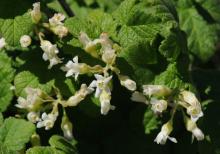
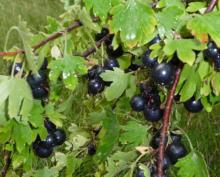
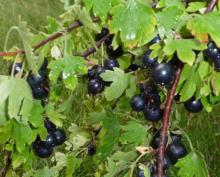
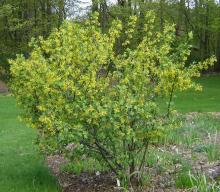
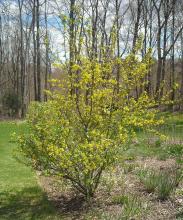
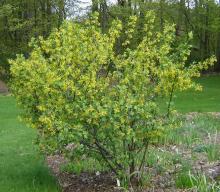
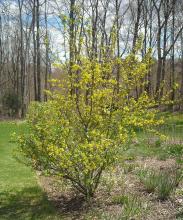

Very attractive foliage there, Rick. Is the dark colour of the leaf center retained through the season?